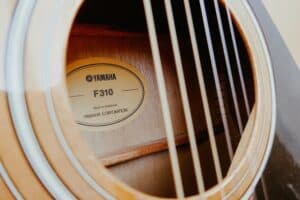
Your guitar is an extension of you. You won’t be comfortable wearing an undersized pair of shoes; you’ll have trouble playing the guitar with the wrong neck width.
So, how wide is a guitar neck, and why is it so important?
Generally, the standard guitar neck width for acoustic guitars is around 41mm (1.61″) to 44mm (1.73″). If you want to play comfortably, you need a guitar with a fitting neck width for your hand and style of play.
Here, you’ll find how to calculate the width of your guitar’s neck and its overall importance.
How To Measure Your Guitar Neck Width?

Measuring your guitar neck width starts with the nut of your guitar.
The nut of your guitar is that hard material at the top of your guitar fretboard just below the guitar’s headstock. It’s where the guitar strings rest, and it plays a crucial role in your guitar tone.
What about the neck of your guitar?
The neck of your guitar is the entire length between the guitar headstock and the remaining body. You’ll find the fretboard, frets, finger markers, and strings on the guitar neck.
Simply put, from the nut of your guitar to the edge of the guitar body is your guitar neck.
So, how do you measure the width of your guitar neck?
There are varying opinions on how to measure your guitar neck. Some believe that you need to measure the nut of your guitar to determine the width of your guitar neck. Others believe that you should measure either the 12th or 14th fret.
However, if you want to get a more accurate measurement of your guitar neck width, it’s better to merge the opinions.
Hence, a better width measurement would include both the nut of your guitar and the base of your guitar neck. Note that the base of the guitar neck varies between the 12th and 14th fret.
How Wide Is A Guitar Neck?
The guitar neck has a unique design. It grows thinner as you approach the guitar’s nut, and it’s wider at the base of the neck.
If you’re measuring only the guitar’s nut, you may want to add an extra value to the measurement. In the same vein, you’ll need to deduct an extra value from the width of your guitar’s neck base.
This way, you’ll have a balanced idea of how wide your guitar neck is.
Although measuring both the nut and the base of your guitar neck gives you a clearer measurement, it is generally believed that the width measurement for the nut of the guitar is equal to the width of the guitar neck.
Simply put, the nut of your guitar is equal to the neck of your guitar.
How To Measure The Nut Of The Guitar
Seeing as it’s generally agreed that the nut is equal to the neck, you should know how to measure the guitar’s nut.
Generally, your nut width measurement starts from the top edge of the nut to the lower edge. This should not be confused with measuring from the low E to the high E strings.
Measuring from the low E to the high E strings is known as string spacing. It is often listed separately from the nut/neck width.
General Measurements of the Guitar Neck Width

Just as there are different types of guitars for different play styles, there are different guitar neck widths. Within a type of guitar, there are also varying guitar and neck sizes.
For acoustic guitars, the general neck width measurement is between 41mm (1.61″) to 44mm (1.73″) for small to medium sizes and 51mm (2″) for wider sizes.
The neck width of steel-stringed acoustic guitars is usually around 43mm (1.69″) or 44mm (1.73″).
Most precision bass (P. Bass) guitars have a medium-sized neck width; hence they’re around 43mm (1.69″) to 45mm (1.77″).
Jazz and classical guitar necks are usually wider than acoustic guitar necks. These are usually around 47mm (1.85″) and 51mm (2″).
Why Is The Guitar Neck Width Important?
The width of your guitar neck affects the way you play your guitar. If your hands are bigger than the nut/neck width, you might find it difficult to move across the strings.
So, it’s better to get a guitar with a fitting neck width for your hand and fingers size.
But that’s not the only reason why the width of your guitar neck is important.
Depending on the style of music you’re playing, you might need a particular type of guitar and neck width.
If you’re into fingerpicking and playing stylishly across the fretboard, you’ll need a guitar with a wider neck width. This is more comfortable for your fingers to run around and hit the notes with ease and accuracy.
Wider guitar necks are, however, not the best for playing jazz or soloing. Why? You’ll need to put in more work in strumming with your pick, as there’s much space between the strings.
Electric guitars are usually the ones with smaller neck width. The narrow neck makes it easy to strum and play as lead. But then, it’s a little difficult fingerpicking on narrow necks.
In playing the guitar, it’s possible to play different styles on any neck width. But, it’s much better and more comfortable to play on the right neck width.
Conclusion
The width of your guitar neck largely influences how you play. You may not be too bothered about the neck width when playing if you’re a pro. But to groom your style of play, it’s better to play on the right neck width.
How wide your guitar neck is, makes the difference between silly mistakes mid-play and a smooth flow. The width of your guitar neck depends on the type of guitar and your playing style.
Remember, the nut width is equal to the neck width.









